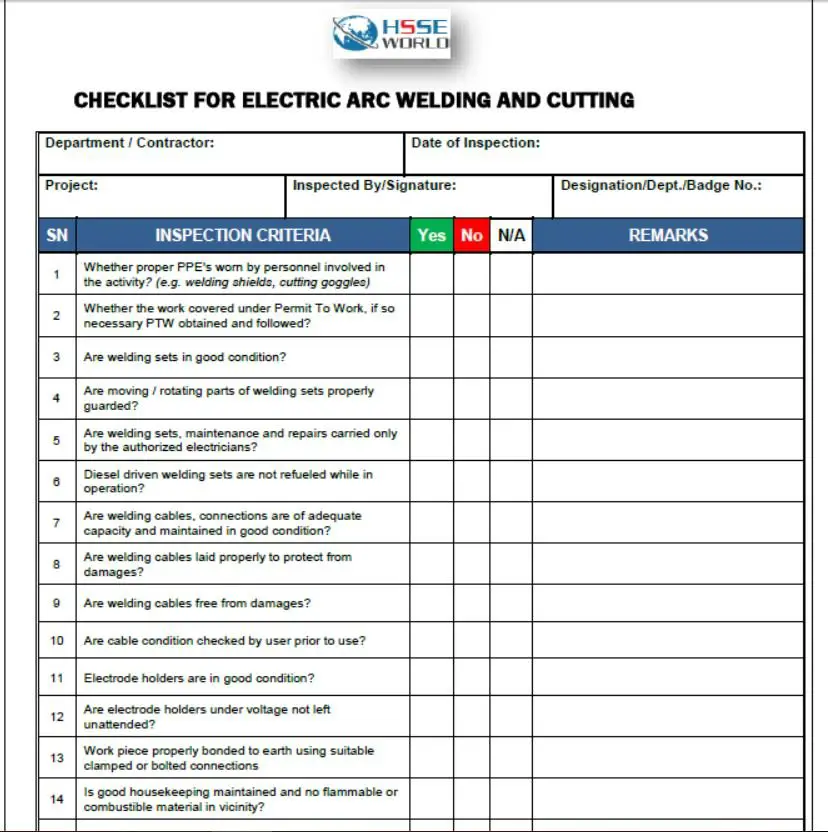Working safely around high-voltage conductors is a challenge for many workers . High-voltage systems are generally associated with utility services and heavy industry, such as pulp mills, sawmills, and mining operations. With care and precise planning, you can operate equipment and tools safely around these potentially lethal power lines.
This part is designed for workers who must work close to high-voltage equipment and conductors. It explains why high-voltage systems are dangerous. It lists the minimum distances you must keep away from live power lines and explains what you should do if you can’t maintain these limits of approach. It also describes common problem areas and gives safe work practices for working close to overhead lines around construction sites and for operating equipment around power lines.
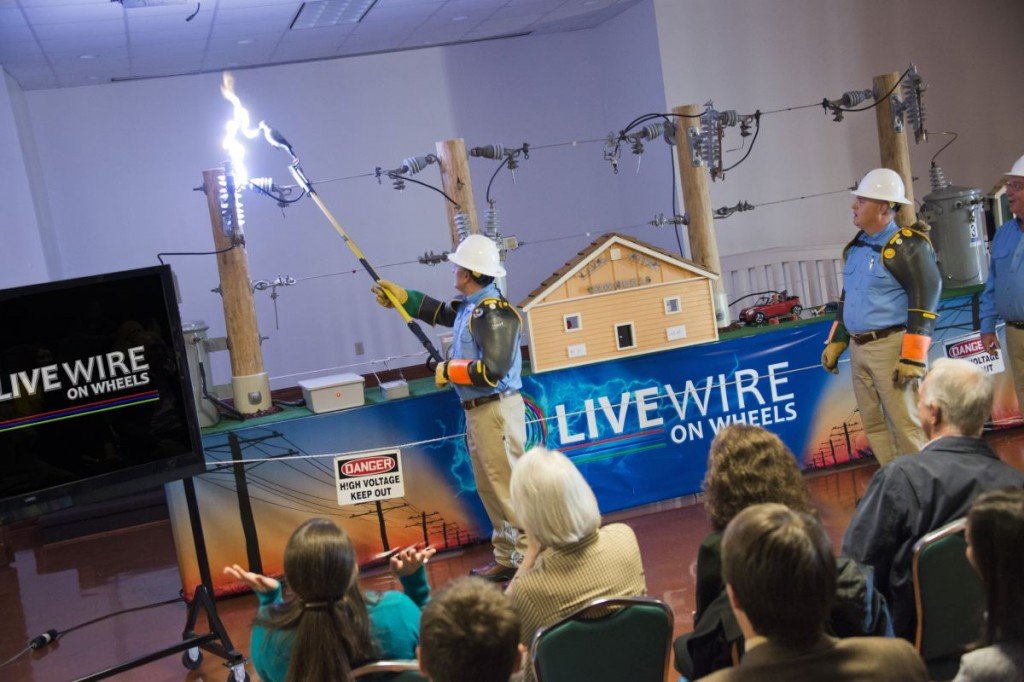
Identifying High-voltage overhead conductors
Overhead high-voltage conductors are usually installed at the top of utility poles. If there is more than one conductor, they are usually placed side by side on a cross arm. If there is a transformer on the pole, the high-voltage conductors are mounted above it. These are general guidelines. Employers are responsible for accurately determining the voltage of all conductors on the pole or in the work area.
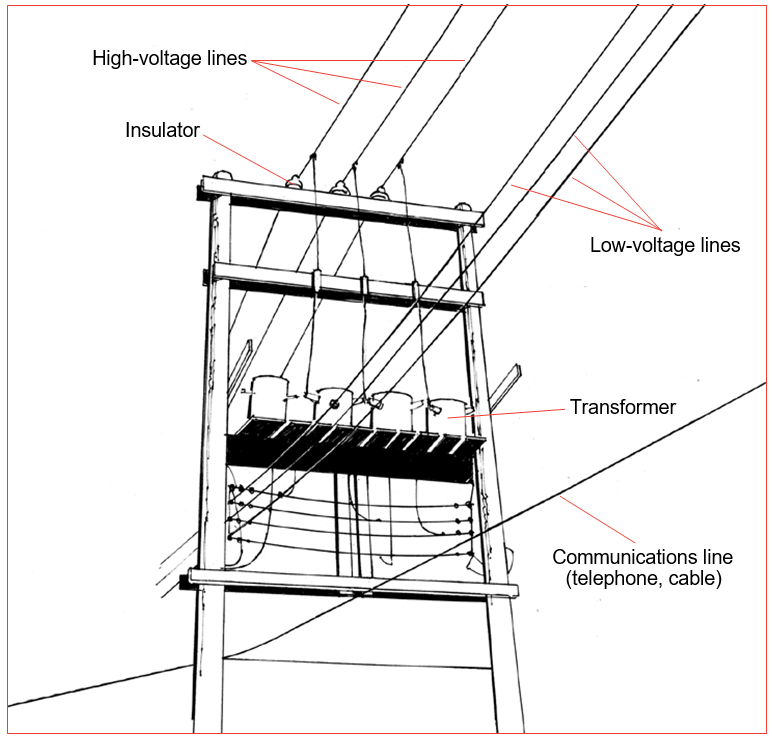
An H-frame configuration may be used to facilitate the installation of transformer bank platforms on older systems. They are most often seen in alleys. The illustration on page 4 shows a common single-pole configuration.
Electrical distribution system
Electricity is transmitted from generating stations and substations via high-voltage transmission lines at 60–500 kV (60,000–500,000 V). These lines are located on top of large towers or poles in transmission rights-of-way. The voltage is reduced at substations in urban areas and distributed by overhead or underground distribution lines.The high-voltage lines on utility poles on our streets are typically at 4–25 kV (4,000–25,000 V).
Why energized high-voltage systems are dangerous
Accidents involving high voltages can result in severe injuries and death. When an electric current passes through the body, it generates heat and can extensively damage internal tissues. In some cases, the entry and exit wounds are so severe that a foot or hand has to be amputated. The electric current can also stop the heart.
Electricity seeks all paths to the ground. That path might include a tree, mobile equipment, or the human body. If a part of the equipment you are operating contacts a live power line, then anything in contact with your equipment will also become energized. The earth itself could become energized for some distance around your unit. Similarly, the ground could become energized if a tree makes contact with a power line or if a broken power line falls to the ground.
When the electrical flow reaches the ground, it spreads out like ripples in a pool of water. The voltage is very high where electrical contact is made with the ground. Farther away from this point, the voltage gradually drops off. Wet ground will extend the distance and the danger.
The voltage at the contact point is approximately the same as the line voltage. With power lines up to and including 60 kV (60,000 V), the voltage drops to zero about 10 m (33 ft.) away from the contact point with the ground. With higher voltages, such as those carried by the lines along transmission rights-of-way, the voltage might not drop to zero until you are as far away as 32 m (105 ft.).

If anything touches a high-voltage power line or if a power line falls to the ground, electricity will flow to the ground, energizing the tree or equipment and anything in contact with it. The surrounding ground may be extremely hazardous. The voltage gradually decreases from the point of contact until it reaches zero. The safe distance shown here — 10 m (33 ft.) — is for line voltages up to and including 60 kV (60,000 V)
Whenever there is a voltage difference between one point and another, a current will flow. It is this flow of electricity (the current) that can cause serious injury or death.
Step potential
Step potential is the voltage difference between two places that are a step apart on energized ground. For example, if you are standing on energized ground, there could be a significant difference in voltage between where one foot and the other are placed, and an electric current could flow up one leg and down the other.

Step potential: If your feet are spread apart on energized ground, electricity can flow through your body from the area of higher voltage to the area of lower voltage.
If your feet are close together and touching, you are fairly safe. Since there is almost no voltage difference between the places where your feet stand, there is little reason for electricity to seek a path through your body.If you find yourself on energized ground and need to move away, you can avoid electric shock or electrocution because of step potential by making sure there is no space between your feet. Shuffle your feet while moving out of the energized area. When shuffling, keep your feet touching at all times to maintain the same voltage in both feet.Similarly, rescue workers must not enter an area that might be energized. Anyone trying to reach an injured worker in an energized area would be exposed to the same danger of step potential. The power lines must be de-energized and grounded before rescue workers or first aid attendants approach.
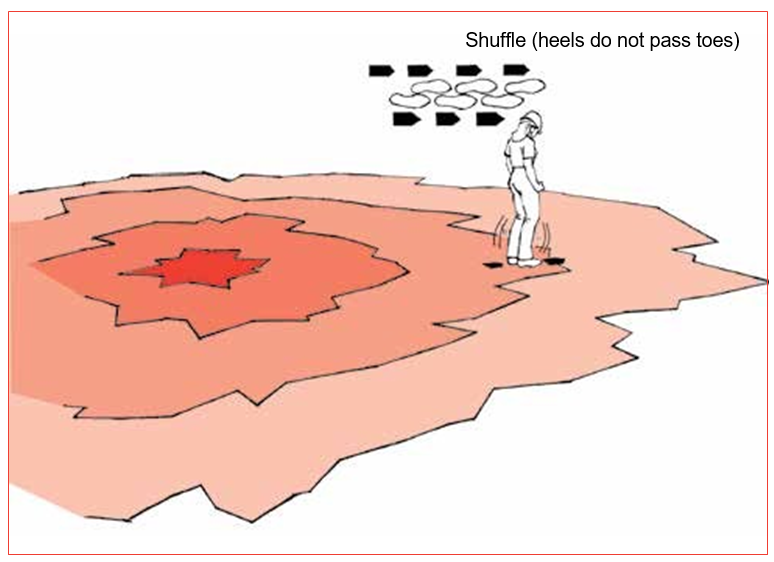
If you must move on energized ground, shuffle while keeping your feet together and touching each other. Don’t take steps.
Touch potential
Touch potential is another danger that comes from the difference in voltage. It occurs when you touch something that is energized while standing on lower-voltage ground. For example, if a tree or equipment is in contact with a power line, it will be energized to the same voltage as the power line; the surrounding ground will be energized to a lower voltage. If you touch the energized equipment or tree at the same time as you touch the ground with your feet, electricity will flow through your body from the higher voltage tree or equipment to the lower voltage ground.
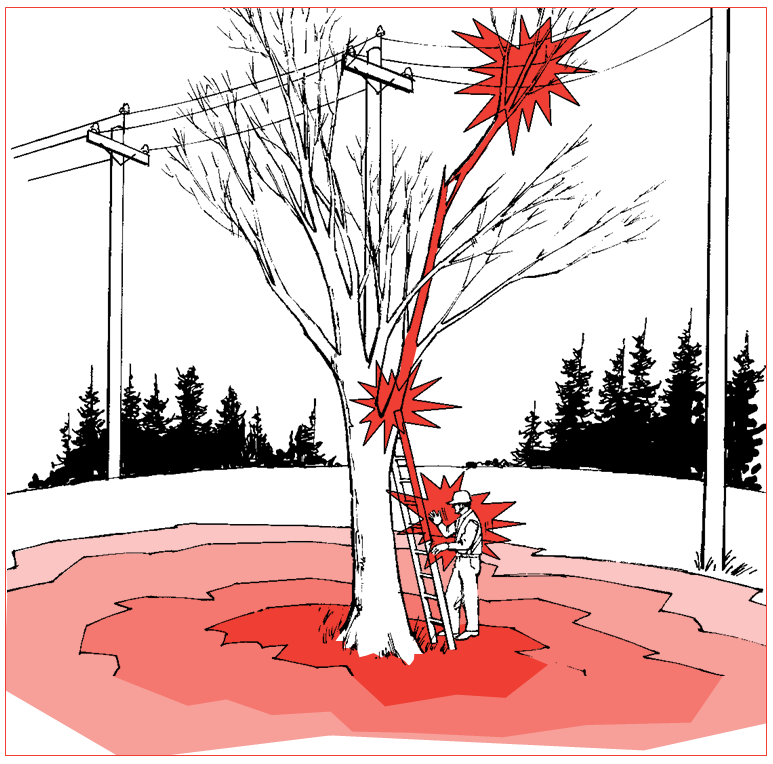
Touch potential: Trees and equipment become energized when they contact a power line. Electricity can flow through anyone who touches the energized tree or equipment, often causing serious injury or death.
Safety in the event of power line contact
Power lines can be brought down in a number of situations, including storms, trees, ice, and motor vehicle accidents. Even if the power line does not come down, if it is in contact with a tree, vehicle, or mobile equipment, the ground will be energized and so will the tree, vehicle, or equipment.
Workers in a vehicle or mobile equipment
If electrical contact is made, stay in the vehicle or mobile equipment if it is safe to do so.
You are relatively safe inside your vehicle as long as you don’t touch or step onto anything outside the vehicle that will provide a path for the current to flow to ground. Wait until the owner of the power system
has verified that the power lines have been de-energized and grounded. In one incident, for example, the raised box of a dump truck hit a
60 kV (60,000 V) power line. The driver stayed in the truck and was
not injured, although all 18 tires were damaged by the electrical current.
If the vehicle is not damaged and is not entangled with the power line, it is safe to drive slowly out of the energized area, at least 10 m (33 ft.) clear of the wires and any wet ground. Because of the danger of exploding tires, large mobile equipment with inflated rubber tires should be moved to an open space away from workers and other equipment. There is a danger of exploding tires for up to 24 hours.
If you must abandon your vehicle because of an emergency such as a fire, be aware that the ground below your machine may be energized and use extreme caution.
To make a safe escape, keep both feet together and hands by your sides, and make a short jump from your vehicle. The goal is to ensure that your entire body clears the vehicle and that you land on your feet without stumbling. Don’t allow any part of your body to touch the vehicle while you are touching the ground.
Don’t take steps away from the vehicle. It is safest to shuffle away without moving your feet more than a few centimetres (a couple of inches) at a time. Keeping your feet together will ensure that you don’t straddle two zones with different voltages.
Rescue work around power lines
The main role for rescue workers near downed power lines or energized equipment is to stop people from getting hurt. Here are some safe work practices:
- Treat downed lines and anything in contact with a power line as Energized wires seldom leap about and give off sparks, so you have no way of knowing whether or not they are energized. Even if the line is not energized, automatic switching equipment may restore power to the line without warning.
- Park well When you arrive at the scene, park your vehicle well away from any downed lines. At night, shine a flashlight through the window to make sure you are not parked anywhere near a downed power line.
- Stop traffic and keep people Workers on foot or in vehicles may not see lines that are lying on the ground. The ground surrounding a downed line will be energized. If a live wire comes in contact with a vehicle, or anything else, that object becomes energized. Secure the area and keep everyone back at least
10 m (33 ft.) — more if the voltage is over 60 kV (60,000 V).
- Don’t let yourself become a victim. Regardless of how badly someone is injured, you cannot help if you are electrocuted. Never touch anything that is in contact with a downed power line, including injured or trapped victims, puddles, vehicles, or trees. Don’t use a dry stick or piece of rope or hose as they will not offer any protection. Don’t enter an area that might be
- Call the owner of the power system and 911 (or other local emergency number) A crew with proper training and equipment will arrive as soon as possible.
- Accept confirmation that the system has been de-energized and is safe only from a representative of the power system who is on site.
HAZARD ALERT
A vehicle contacted a high-voltage power line. When a police officer arrived at the scene, the vehicle was still energized. The police officer walked toward the vehicle. The officer’s legs started tingling about 2 m (6 ft.) away from the vehicle. The officer was fortunate not to be seriously injured or electrocuted.
General limits of approach
The key to safety is to keep a safe distance from overhead and underground power lines. Part 19 of the Regulation lists the distances that workers must keep away from exposed energized conductors.
Table -1A in the Regulation gives the general limits of approach. This is the minimum distance from overhead energized high-voltage lines that non-qualified workers and their materials, equipment, and machinery must maintain.
The limits of approach vary with the voltage. The tools and equipment that you hold or operate are an extension of your reach. You must ensure that you have enough room for movement with your tools without violating these limits.

The movement of equipment and tools must be carefully planned to avoid entering within the general limits of approach. Employers must accurately determine the voltage and minimum limits of approach. To do so, contact the owner of the power system. Employers must also ensure that:
- Supervisors and workers know the location of all electrical power sources in the work area before starting work
- Supervisors review the general limits of approach with all workers who work near energized high-voltage equipment or power lines
- Supervisors hold pre-job safety meetings (tailgate meetings) and document the meetings
Supervisors and workers must maintain the minimum distance from electrical conductors at all times. The minimum distance is measured from the extreme outside dimension of mobile equipment, tools, or materials being handled. The outside dimension may be the tip of an extended equipment boom, a paint roller, or a long pipe that you are lifting. The electrical conductor may be a wire, a transformer, or any other energized component that conducts electricity. All workers need to know the safe limits of approach to electrical conductors and must not get any closer.
Working inside the limits of approach
After first checking the worksite, you may find that the minimum distance from the electrical conductor cannot be maintained. If inadvertent movement by a worker or equipment may result in either coming closer than these minimum distances, you must follow these steps before proceeding with work:
- Call the owner of the power system and arrange for a worksite meeting to decide whether the energized electrical conductors can be:
- Displaced or rerouted, or
- De-energized (isolated and grounded), or
- Visually identified and effectively
- Get assurance in writing from the owner of the power system indicating which of the three actions will be taken and when this will be done. The owner of the power system will do this on form 30M33, available from any WorkSafeBC office or the owner of the power system. No work can be done within the limits of approach until one of the conditions in step 1 has been met and the completed form 30M33 is on site. It takes time to complete the form 30M33 process, so it’s important to plan
- Inform all workers near the power lines of the information in form 30M33. Make sure they are trained in appropriate safe work procedures.
- Designate a qualified safety watcher who can monitor equipment and material movement and give an instant “stop” signal to the equipment operator when the equipment or load is too close to the electrical conductor. Workers, equipment, tools, and loads must not contact the guarding under any
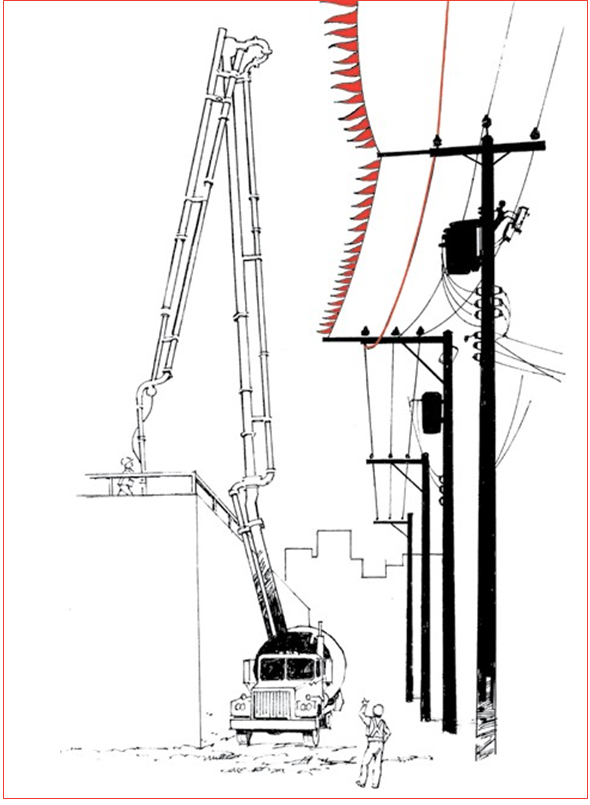
Guarding is a visual warning only. The grounded guard wire (with flags) gives warning of approach. The overhead line cover-up, installed by the owner of the power system, has no insulated rating for the purposes of form 30M33. Workers and equipment must not contact the guard wire or overhead line under any circumstances.
Common problem areas
The rest of Part 2 highlights areas where workers have been injured while working near high-voltage conductors. It also offers suggestions to help you prevent similar incidents and to keep you and your co-workers safe near power lines.
Construction sites near power lines
Each year workers in many places die or are seriously burned as a result of unsafe work practices around energized conductors. The following information is a reminder to operators of construction equipment and to construction and maintenance workers who must work near power lines:
- Most power lines are found overhead; however, some are buried just a short distance below the surface of the
- The normal operating range of your machine or equipment can often reach either the overhead or the underground power lines above or below
- Supervisors and operators of equipment can prevent electrical accidents through knowledge of electrical systems and safe work
HAZARD ALERT
A tower crane operator working from the top of a high-rise building was hoisting material to different floors. The operator had completed a lift and returned the bucket to the ground loading area. While the operator was re-positioning the bucket, the hoist cable slackened excessively and crossed over a 12 kV (12,000 V) power line, energizing the hoist cable. Fortunately, no one was injured in this near miss
HAZARD ALERT
Recertifying equipment after electrical contact
When a machine contacts a power line, the passage of current through the machine can impair the strength of some of its parts. Any hoisting or aerial device that has contacted an energized conductor must be recertified by a professional engineer before it is returned to service. It is recommended that a licensed mechanic check other mobile equipment that has contacted a power line.

Serious injuries or death can result if any part of a crane touches a power line
Mobile equipment near power lines
Operators of mobile equipment such as cranes, hoists, and backhoes must take care that no part of the equipment makes contact with an overhead power line. If any part of the equipment contacts an overhead power line, remember that the operator is safer inside the machine than on the ground
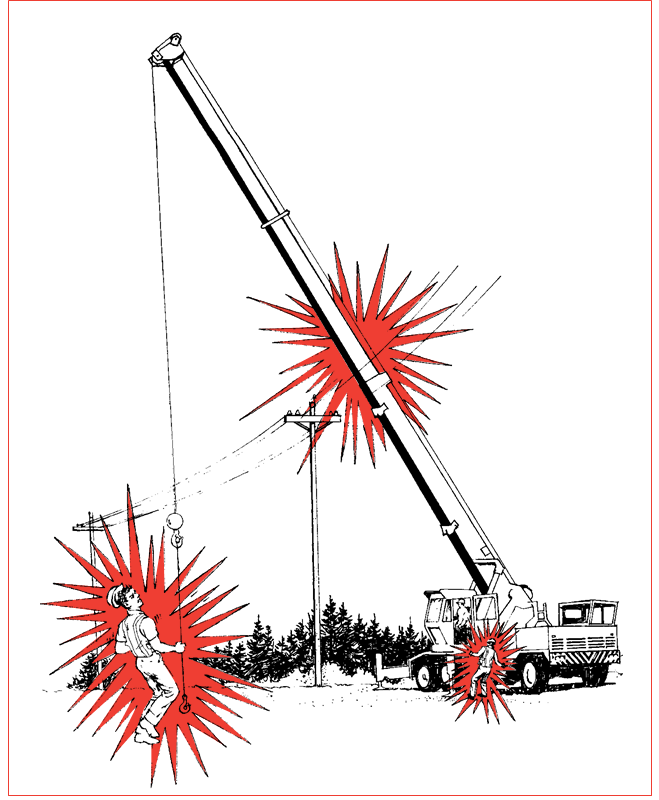
If mobile equipment touches a power line, electricity can travel from the power line to a worker touching any part of the equipment, including a pendant control.
HAZARD ALERT
A worker was on the ground guiding a mobile crane onto a truck deck when the crane’s boom contacted a power line. The electrical current passed through the crane jib that the worker was holding and then passed through the worker to the ground. The worker was electrocuted.In another accident, a pumper truck operator was lowering the truck’s boom after pouring concrete. He was standing away from the truck using the pendant control. The boom contacted the high-voltage line and power came through the pendant line to the operator. The operator was electrocuted.
If you operate mobile equipment near power lines, take the following precautions:
- Keep your mobile equipment, work materials, and tools a safe distance from power lines. This is your first line of defence when operating mobile equipment near overhead power
- If it is necessary to operate equipment closer than 6 m (20 ft.) to a power line, contact the owner of the power system to find out the voltage of the line. Then consult the table on page 32 to find the minimum distance away from the line you are allowed to work. If it is not possible to keep this distance, the owner of the power system may need to de-energize or reroute the circuit, or provide guarding. Don’t proceed until the owner of the power system has given written assurance defining proper
- Don’t stand on the ground beside your machine to operate the remote controls for the equipment. If a power line contact occurs, current will flow through the machine to the ground. If your feet are on the ground and you touch the electrified machine, current will pass through your body to the ground. An electrical contact will also energize the ground around the machine for some distance, up to at least 10 m (33 ft.) — more if the lines carry voltages higher than 60 kV (60,000 V).
- If you must operate controls from the ground, the remote control signal should be carried by radio or non-conductive cable such as fibre If the fibre optic cable has armouring with metal bands, it will be conductive. In addition, you should stand well clear when operating equipment with a remote control — depending on the voltage, at least 10 m (33 ft.) away from your machine and the power lines.
Travelling under power lines
Know the height of your load and the height of the power lines you will be travelling under. Always make sure there is sufficient clearance for your load to travel safely under the power lines
HAZARD ALERT
A skidder was towing a line log loader down a road alongside a power line. While the skidder operator was manoeuvring out of a small turnout, the snorkel guyline contacted the power line. Both machines were energized. Although two workers tried to signal to the skidder operator to stay in the vehicle, he jumped to the ground while still touching the energized skidder and was electrocuted.
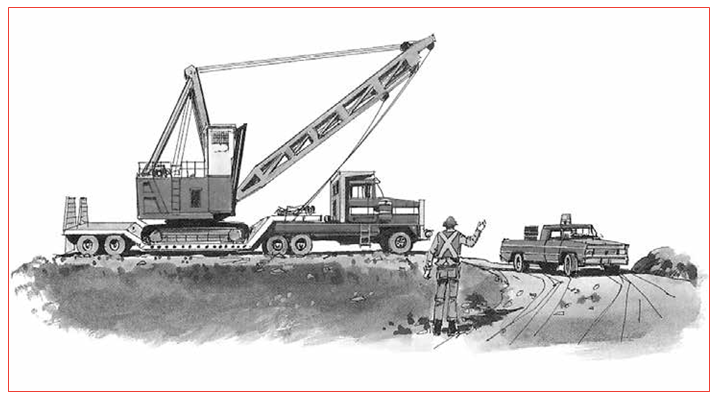
The boom of the grapple yarder has been lowered for transport.
Pruning or falling trees near power lines
Workers have been killed or injured when doing tree care work or falling trees near power lines. Before workers prune or fall trees close to a power line, a qualified person must inspect the worksite to identify any hazards, including situations where any part of a tree is within the general limits of approach or could fall within that distance. The owner of the power system must authorize the person doing the inspection and ensure that the person is qualified.
If tree pruning or falling will come within the general limits of approach, workers must be authorized by the owner of the power system to do the work. Normally the only worker authorized to do this work will be a qualified electrical worker, a certified utility arborist, or an apprentice utility arborist working under the direct supervision of a certified utility arborist or a qualified electrical worker.
Tree pruning or falling is not allowed within the general limits of approach unless both of the following are true:
- A certified utility arborist or qualified electrical worker is present at the site and directing the
- At least one additional qualified person, trained in appropriate emergency rescue, is
HAZARD ALERT
A tree trimmer was up in a tree trimming branches about 2.5 m (8 ft.) away from a power line. When he cut a tree branch, it fell onto the power line and the other end hung against the trunk of the tree. The worker received a fatal shock when he tried to free the branch from the tree.
Scaffolds and other equipment near power lines
The limits of approach must be maintained for all scaffolds and equipment near power lines. For example, workers on scaffolds or window-washing platforms must not let any tools, such as pipes or rollers, come within the limits of approach. Scaffolds must be positioned and secured in a manner to prevent them from coming into contact with adjacent power lines.
Farm equipment can cause accidents when it contacts power lines. Farm workers have been electrocuted when metal irrigation pipes have been lifted up, touching overhead power lines. Where practicable, store metal irrigation pipes at least 30 m (100 ft.) away from overhead power lines.
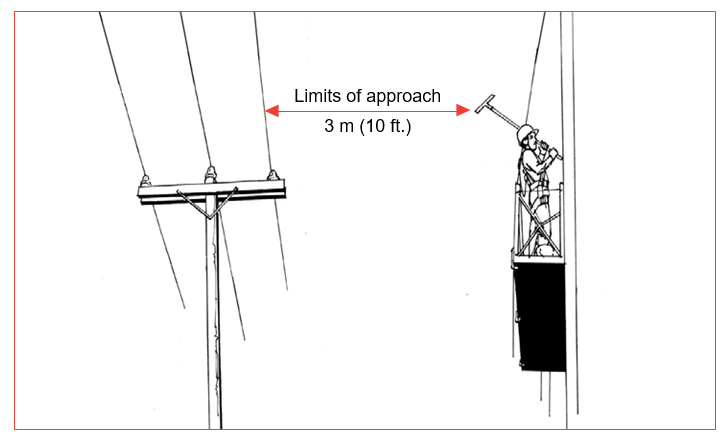
A tool is an extension of your reach and must not come within the limits of approach
HAZARD ALERT
A construction worker was erecting tubular scaffolding 3 m (10 ft.) from an energized 25 kV (25,000 V) conductor. The worker was handling a long section of bracing, which accidentally contacted the power line. The worker was electrocuted.
Utility poles
Don’t work close to utility poles if the work could cause a pole to become unstable or if you can’t maintain the limits of approach. If any poles are unstable, ask the owner of the power system to support or remove them. Workers must not climb poles supporting power lines unless they are qualified and authorized by the owner of the utility.
HAZARD ALERT
A worker was excavating a trench beside a utility pole. The pole was undermined when too much soil was removed next to the pole. The pole fell over, causing high-voltage lines to fall near the worker. Fortunately, the worker was not injured.
Underground utilities
Low-voltage and high-voltage underground wiring is used for supplying power to schools, commercial buildings, homes, and numerous other sites. Drilling, excavating, or probing can be dangerous near buried electrical lines. Check with the owner of the power system for the existence and location of underground lines before you start digging.
Workers have died because their shovel blade penetrated a live high- voltage electrical cable. A treated-wood plank buried on top of the cable may be the only protection for the cable. Modern installations often have a bright yellow plastic ribbon buried below the surface to warn that a cable lies beneath it. “Danger — High Voltage” signs warn that high-voltage equipment is enclosed inside and buried underground. Don’t take chances — contact the owner of the power system before you start digging. You must accurately identify the location of underground utilities before you dig. Besides electricity, there are other kinds of underground utilities, including telephone, gas, cable, water, and pipeline services.

Find out the locations of any underground cables before you begin work.
The following activities are potentially hazardous because workers may contact buried power lines:
- Driving ground rods or any other long metal objects into the ground
- Digging holes for fence posts
- Digging near “Danger — High Voltage” signs
- Trenching
HAZARD ALERT
A worker was breaking concrete when his jackhammer broke through a conduit. The tool contacted an energized 15 kV (15,000 V) underground cable. The worker was electrocuted
3 keys of electrical safety
1. Look up and down.
All workers who operate machinery or equipment that could come in contact with power lines should look up and check for overhead power lines before beginning work or identify underground power lines in the vicinity. Plan your work to prevent electrical contact.
2. Keep back — Know your limits.
When operating machinery or equipment in close proximity to power lines, always maintain the limits of approach: 3–6 m (10–20 ft.), depending on the voltage. Use a spotter to make sure you keep equipment away from power lines.
Where any portion of a machine or equipment may come closer than the minimum distance prescribed, form 30M33 must be completed before work begins. This allows the owner of the power system to provide some form of protection.
On the ground stay at least 10 m (33 ft.) away from operating equipment because if it contacts an energized line the electricity will go to ground. The operator should be on the vehicle with everyone else clear of the vehicle when the boom is in motion. If you must approach, ensure the equipment is not operating.
3. Stay back, and call for help.
Stay back at least 10 m (33 ft.) from a fallen power line, exposed underground power line, or any object in contact with the line. If the machinery you are operating contacts an energized line, move it away from the line to break contact. If you can’t do this, stay put in the machine until help arrives.
If it’s a life-threatening situation such as a fire, jump clear of the machine, keeping your feet together. Never contact the machine and the ground at the same time. Once clear of the machine, shuffle away, never allowing the heel of one foot to move beyond the toe of the other. Keep shuffling until you are at least 10 m (33 ft.) away from the machine; this is the safe distance for voltages up to and including 60kV (60,000 V).
Depending on the voltage, you may need to get as much as 32 m (105 ft.) away from the machine.
Always call your local emergency services when someone is injured in an electrical accident. Don’t attempt a rescue until directed by Hydro personnel. If you touch an injured person who is still in contact with an electrical source, you could be seriously injured or killed. Keep everyone back at least 10 m (33 ft.), and have someone call for help immediately.



